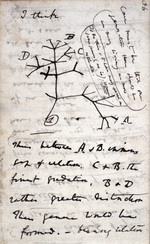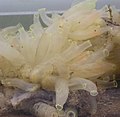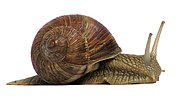A chordate (/ˈkɔːrdeɪt/ KOR-dayt) is a deuterostomic bilaterial animal belonging to the phylum Chordata (/kɔːrˈdeɪtə/ kor-DAY-tə). All chordates possess...
55 KB (5,168 words) - 13:54, 31 August 2024
The Cambrian chordates are an extinct group of animals belonging to the phylum Chordata that lived during the Cambrian, between 538 and 485 million years...
24 KB (2,720 words) - 21:04, 11 July 2024
Chordate genomics is the study of the evolution of the chordate clade based on a comparison of the genomes of several species within the clade. The field...
3 KB (464 words) - 14:57, 14 February 2018
notochord. It is a paraphyletic grouping including all animals excluding the chordate subphylum Vertebrata, i.e. vertebrates. Well-known phyla of invertebrates...
45 KB (5,000 words) - 08:01, 8 September 2024
This article contains a list of all of the classes and orders that are located in the Phylum Chordata. Order Amphioxiformes Order Enterogona Order Pleurogona...
14 KB (943 words) - 12:45, 14 September 2024
urochordates is still sometimes used for these animals. They are the only chordates that have lost their myomeric segmentation, with the possible exception...
63 KB (7,336 words) - 09:13, 9 September 2024
hollow nerve cord of chordates. Both the hemichordates and the chordates have a thickening of the aorta, homologous to the chordate heart, which contracts...
35 KB (3,202 words) - 13:25, 16 September 2024
comprising all that lack vertebral columns, which include non-vertebrate chordates such as lancelets. The vertebrates traditionally include the hagfish,...
78 KB (7,094 words) - 14:43, 20 August 2024
PMC 11267725. "Cambrian Primitive Chordate Fossil". www.fossilmuseum.net. Retrieved 29 May 2018. "Duffy: Chordate Origins". www.biology.ualberta.ca....
3 KB (208 words) - 17:06, 30 July 2024
Lamprey (section Lamprey and chordate synapomorphies)
their development are considered to be chordates. Lampreys contain these characteristics that define them as chordates. Lamprey anatomy is very different...
84 KB (8,924 words) - 21:21, 31 August 2024
anatomy is a potential result of speciation and habitat variation. The five chordate synapomorphies are present in chondrichthyes as follows. The five synapomorphies...
33 KB (4,253 words) - 03:33, 18 September 2024
Pikaia (category Prehistoric chordate genera)
Morris as a chordate, it became "the most famous early chordate fossil", or "famously known as the earliest described Cambrian chordate". It is estimated...
50 KB (5,780 words) - 00:23, 14 August 2024
feeding chordates in the subphylum Cephalochordata, class Leptocardii, and family Branchiostomatidae. Lancelets diverged from other chordates during or...
63 KB (6,458 words) - 17:52, 18 September 2024
Haikouichthys (category Cambrian chordates)
have considered Haikouichthys to be synonymous with the other primitive chordate Myllokunmingia, but subsequent studies led by the British paleontologist...
8 KB (772 words) - 23:40, 24 June 2024
Craniate (category Chordates)
member of the Craniata (sometimes called the Craniota), a proposed clade of chordate animals with a skull of hard bone or cartilage. Living representatives...
17 KB (1,632 words) - 23:25, 23 August 2024
The Ancestor's Tale (section Non-mammal chordates)
mya Lancelets (Amphioxiformes) Lancelets are a text book example of a chordate. Equipped with a notochord, a nerve tube on the dorsal side and gill slits...
54 KB (984 words) - 06:02, 1 August 2024
Yunnanozoon (category Cambrian chordates)
with various studies suggesting placements as a cephalochordate, a stem-chordate, a hemichordate, a stem-vertebrate, a stem-deuterostome, an ambulacrarian...
7 KB (706 words) - 18:22, 30 July 2024
crustaceans, arachnids, insects, worms, radiates, polyps, and infusorians. Chordates are remarkably wormlike by ancestry. In the 13th century, worms were recognized...
10 KB (1,002 words) - 09:44, 28 May 2024
In the developing chordate (including vertebrates), the neural tube is the embryonic precursor to the central nervous system, which is made up of the brain...
13 KB (1,522 words) - 13:52, 10 August 2024
in hemimetabolous insects. In chordates, metamorphosis is iodothyronine-induced and an ancestral feature of all chordates. All three categories of metamorphosis...
23 KB (2,677 words) - 13:46, 3 July 2024
Notochord (category Chordate anatomy)
five synapomorphies, or characteristics used to define a species as a chordate. The notochord is derived from the embryonic mesoderm and consists of an...
21 KB (2,359 words) - 16:17, 29 August 2024
symmetry; The latter indicates that they belong to the Bilateria, along with chordates, arthropods, annelids and molluscs. Sea urchins are found in every ocean...
80 KB (8,034 words) - 17:20, 16 September 2024
conserfariam) Socorro isopod (Thermosphaeroma thermophilum) There are 21 chordate species assessed as extinct in the wild. Wyoming toad (Anaxyrus baxteri)...
4 KB (291 words) - 14:25, 24 June 2024
phylogenetic relatives of chordates. Thus these marine worms are of great interest for the study of the origins of chordate development. There are several...
25 KB (2,706 words) - 03:10, 5 September 2024
Olfactores (category Chordate unranked clades)
majority of the phylum Chordata, as the Cephalochordata are the only chordates not included in the clade. This clade is defined by a more advanced olfactory...
6 KB (575 words) - 06:10, 31 August 2024
Ascidiacea (category Chordate classes)
approximation of ancestral chordates, they can provide insight into the link between chordates and ancestral non-chordate deuterostomes, as well as the...
41 KB (4,900 words) - 03:08, 15 September 2024
The largest animal currently alive is the blue whale. The maximum recorded weight was 190 tonnes for a specimen measuring 27.6 metres (91 ft), whereas...
162 KB (16,263 words) - 23:42, 19 September 2024
(a group which as a whole includes the vertebrates, other invertebrate chordates, echinoderms and hemichordates). The general scientific consensus before...
20 KB (1,788 words) - 13:01, 14 September 2024
animal species — far behind the arthropods' 1,113,000 but well ahead of chordates' 52,000.: Front endpaper About 200,000 living species in total are estimated...
96 KB (9,722 words) - 07:15, 10 September 2024
represent the oldest known craniates, a proposed group of chordates that contain all chordates with a cartilage-derived skull (i.e., lampreys, armored agnathans...
5 KB (430 words) - 11:33, 16 September 2024


























